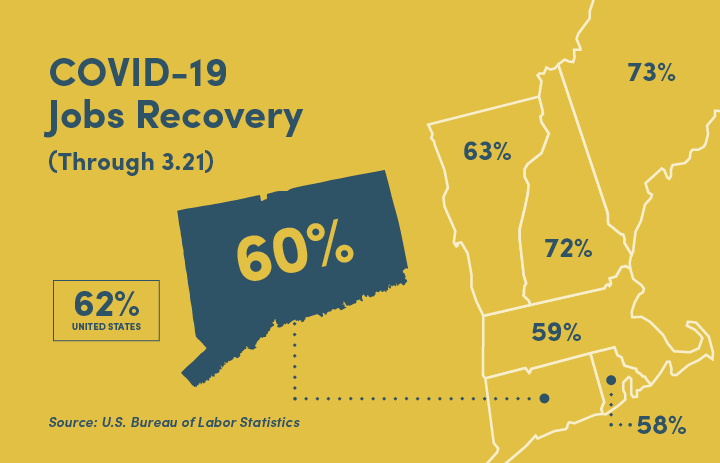March Marks Three Months of Job Gains; COVID Recovery at 60%

Connecticut’s COVID-19 jobs recovery gained momentum in March, with employers adding 5,400 positions, marking a third consecutive month of gains.
The state has now recovered 60% of the 292,400 jobs lost last March and April to COVID-19 shutdowns and restrictions.
The March surge was led by big gains in the education and health services, leisure and hospitality, and construction sectors, while several other key sectors posted concerning losses.
CBIA president and CEO Chris DiPentima called the March employment report “very good news,” noting the jobs market was rebounding after finishing 2020 with two months of losses.
“We’re encouraged to see three consecutive months of gains, although the significant loss of jobs last month in the trade, transportation, and utilities and professional and business services sectors is concerning,” DiPentima said.
Recovery Prospects
DiPentima said while the state was poised for recovery, employers were casting a wary eye at the state Capitol as lawmakers considered tax hikes and a range of new workplace mandates.
“There are 90,000 fewer people employed in the private sector today than there were a year ago, and that must be a significant factor as the legislature moves through the budget writing process,” he said.
“Connecticut’s recovery from the pandemic should be about driving investment in our economy and doing everything possible to encourage job growth.
“Employers are looking for lawmakers to show signs of predictability and stability, particularly with tax policy.
“We have a choice whether to continue to see this month-to-month job growth, or undermine it with bad policy. The last thing we need at this critical time are new tax burdens or labor mandates on struggling businesses and residents.”
DiPentima also said it was critical that the legislature and Lamont administration support struggling small businesses by using federal coronavirus relief funds to address the state’s unemployment fund debt crisis.
Unemployment Rate
Maine has recovered 73% of its COVID-19 job losses and leads the New England states.
New Hampshire’s recovery rate is 72%, followed by Vermont (63%), Connecticut, Massachusetts (59%), and Rhode Island (58%). The national recovery rate is 62%.
Connecticut’s unemployment rate fell two-tenths of a point to 8.3%, the highest in New England.
Connecticut’s unemployment rate fell two-tenths of a point in March to 8.3%, the highest in New England and well above the national rate of 6%.
At 2.9%, Vermont’s jobless rate is the lowest in the region, followed by New Hampshire (3%), Maine (4.8%), Massachusetts (6.8%), Rhode Island (7.1%), and Connecticut.
Sector Gains, Losses
Seven of the state’s 10 major industry sectors added jobs in March, with education and health services driving overall growth with the addition of 5,400 new positions.
Leisure and hospitality gained 1,600 jobs, followed by construction and mining (1,100), manufacturing (700), financial activities (600), other services (400), and government (400).
March’s overall job gains were partially offset by the troubling declines in professional and business services (-2,600), trade, transportation, and utilities (-2,100), and information (-100).
Seven of the state’s 10 major industry sectors added jobs in March, with education and health services driving overall growth.
Trade, transportation, and utilities continues to lead all sectors in recovering COVID-19 losses, regaining 93% of the 54,800 jobs lost last Spring.
The construction sector’s recovery rate is 78%, followed by other services (70%), leisure and hospitality (61%), education and health services (54%), manufacturing (36%), government (35%), and professional services (-34%).
The information (-36%) and financial activities (-6%) sectors have continued to lose jobs since last April.
Labor Markets
Five of the state’s main labor market areas added jobs last month, led by New Haven with 5,500 new positions (2%).
Bridgeport-Stamford-Norwalk gained 1,100 new jobs (0.3%), followed by Norwich-New London-Westerly (900; 0.8%), Danbury (200; 0.3%), and Waterbury (100; 0.2%).
Overall, Connecticut has 103,000 less jobs than it did a year ago.
Hartford-West Hartford-East Hartford lost 200 jobs in March (-0.04%).
Overall, Connecticut has 103,000 less jobs (-6.1%) than it did a year ago, with Norwich-New London-Westerly seeing the largest declines in percentage terms (-9.1%; -11,600).
Danbury has 5,800 fewer jobs than March last year (-7.5%), followed by Bridgeport-Stamford-Norwalk (-7%; -28,000), Hartford (-6.3%; -36,800), Waterbury (-3.8%; -2,600), and New Haven (-2.1%; -6,300).
RELATED
EXPLORE BY CATEGORY
Stay Connected with CBIA News Digests
The latest news and information delivered directly to your inbox.



